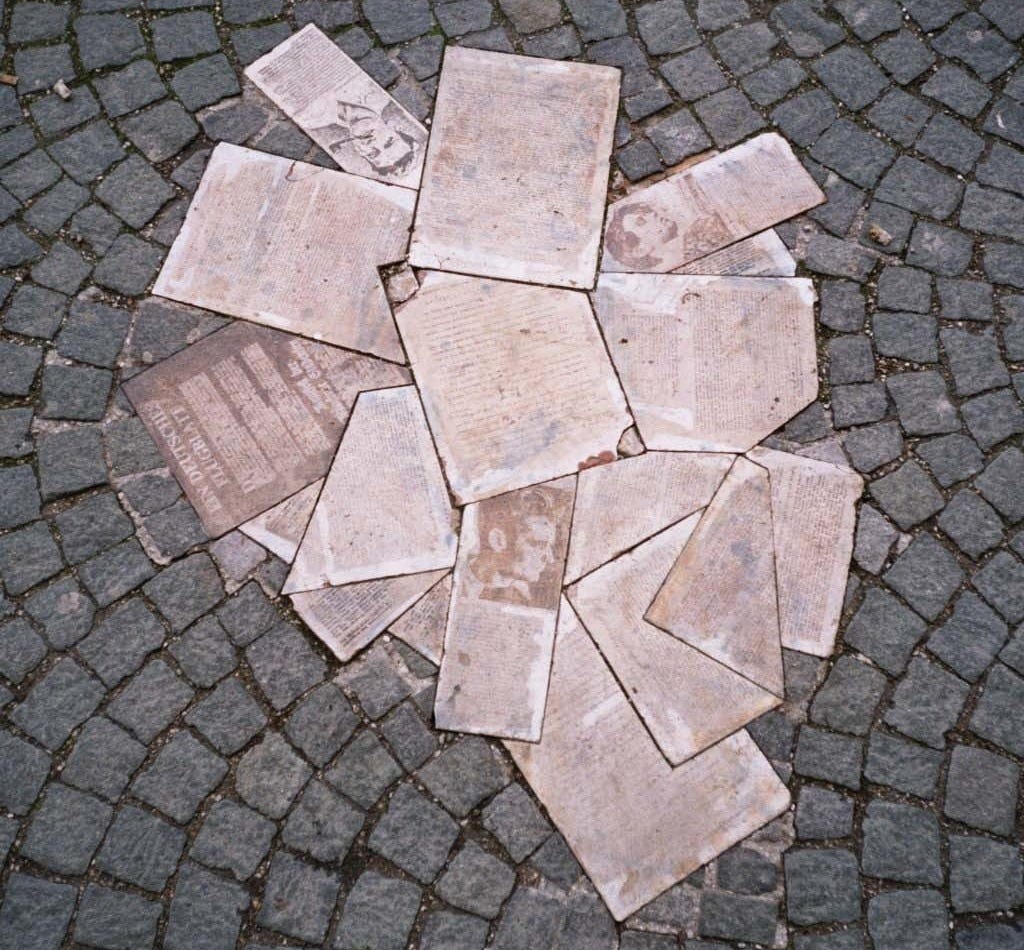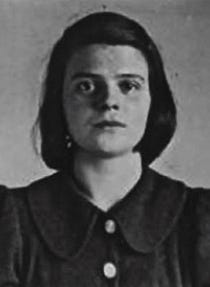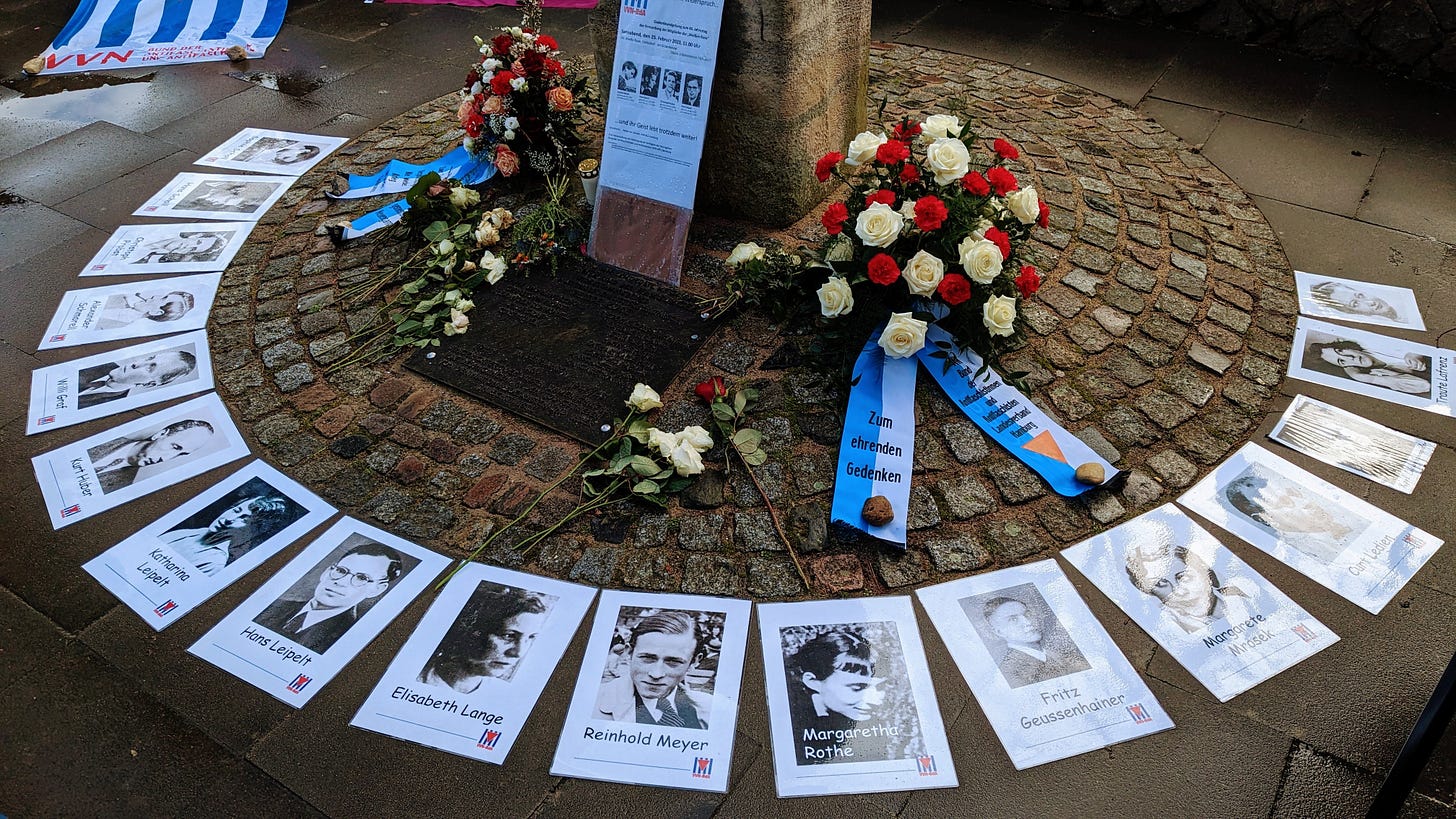Chapter 42: Fighters Against Their Times
The White Rose Resistance Movement
A unique resistance movement opposing the Nazi regime sprang up suddenly and unexpectedly in Munich in June of 1942. The movement was unexpected because its leader, Hans Scholl (1918 – 1943), started off as a member of the Hitler Youth.
Scholl came from a middle-class family in Ulm, a small city on the Danube about 90 miles west of Munich. He was selected for the honor of being a standard-bearer at the giant Nazi party rally in Nuremberg in 1935.1 He was “the obvious choice” for this recognition “because he was the most ardent and the handsomest boy in his unit.”2
With time, Scholl’s ardor cooled. He came to see Nazism for what it was. He enrolled as a medical student at the Ludwig Maximilian University of Munich and was sent with the Wehrmacht as a medic first to the western front (i.e., France) in 1940 and then to the eastern front (i.e., Poland and the USSR) in 1941. Unlike so many others, Scholl could not close his eyes to the horrors being perpetrated against Poles, Russians, and Jews. When he and a like-minded friend, Alexander Schmorell (1917 – 1943), returned to Munich, the two realized that they had to take action in the face of a regime which they rightly understood as monstrous beyond description.
Scholl and Schmorell composed and distributed four leaflets when they were home on leave. The first appeared in late June of 1942. “For the first time in the history of the Third Reich, opposition to Adolf Hitler and his regime had broken through to the light of day and become visible. . . .”3
The second leaflet pinpointed an issue which is as urgent today in dealing with Trump as it was in 1942. “It is impossible to discuss National Socialism rationally because there is nothing rational about it. . . .”4 The fourth leaflet concluded with this memorable declaration: “We will not be silent. We are your bad conscience. The White Rose will not leave you in peace!”5 Hans Scholl and Alexander Schmorell were soon to be joined by Christophe Probst (1919-1943), Willi Graf (1918-1943), Sophie Scholl (1921-1943), Hans’s 21-year-old sister, and Professor Kurt Huber (1893 – 1943) of the University of Munich. All six of these people would pay for their commitment to the White Rose with their lives.

No leaflets were produced between July of 1942 and January of 1943 because key people were serving in the military on the eastern front. Two more leaflets were written and distributed in January and February, and a seventh leaflet was written but not distributed. The Scholl siblings and Christophe Probst were arrested on February 18, and they were executed by guillotine on February 22.
Freedom was what Hans and Sophie Scholl and their companions wanted. “Freiheit” – “Freedom” – was, in all probability, the last word Sophie ever wrote.6 Moments before his death, Hans Scholl shouted “Es lebe die Freiheit!” – “Long Live Freedom.”7

These courageous people were battling against very long odds. In the words of a survivor of the White Rose effort, “It is my firm belief that no one raised in the United States can fully comprehend what it is like to live under an absolute dictatorship. . . . [And let’s hope we never find out]. The government - or rather, the [Nazi] party - controlled everything: the news media . . . [the] police, the armed forces, the judiciary, communications, travel, all levels of education from kindergarten to universities, all cultural and religious institutions. Political indoctrination started at a very early age, and continued by means of the Hitler Youth with the ultimate goal of complete mind control.”8
The White Rose demanded the freedom to tell the truth, and they were also fighting for Christianity as they understood it. Indeed, what it means to be a Christian is very much at issue in our own nation today as it was in Germany in the early 1940s.
Perhaps in part because they were people of faith, the White Rose movement could conduct its courageous but doomed crusade without hate. Sophie Scholl’s mother’s last words to her were “remember Jesus.”9 They spoke for the cross of Jesus Christ not for the swastika - the twisted cross of the Nazis.
The most precious gift the White Rose has given us is to witness the power of truth. Through all the propaganda in which Germany from 1933 to 1945 was bathed, through the incessant marching and parades and spectacles, through the Hitler salute, ”Heil Hitler,” which made Adolf Hitler a part of every conversation and of every human interaction (and it is worth noting that Jews were not permitted to give the Hitler salute as of 1937, thus advertising their isolation)10 through all this theater, the White Rose saw the truth. As one of them put it: The goal of the White Rose is “to call out the truth as clearly and audibly as possible into the German night.”11 The people of the White Rose told the truth in spite of being surrounded by lies and stalked by terror.
And they did not hate. Hans Scholl, said to his parents at their last meeting – literally minutes before he was sent to the guillotine – “I have no hate for anyone. . . .”12 How remarkable that is. They may have hated the sin. They did not hate the sinner.
That is our assignment today, whether we are people of faith or not. We are free – at least for now - to call out the truth and to do so without hate.
The fourth leaflet of the White Rose states “Every word that comes out of the mouth of Hitler is a lie.”13 Trump is not Hitler, but in this particular something very similar could be said of Trump. He lies and lies and lies. He lies all the time.

Donald Trump is not the first President to lie. However, there is an aspect of his lying which is particularly toxic. Let us focus on one lie of the thousands that he has told. He insists that he won the election in 2020 and that the riotous mob that he summoned to Washington to deface the Capitol on January 6, 2021, was composed of “patriots” and “hostages.”14
This lie is extraordinarily dangerous because it strikes at the heart of democracy. What democracy enables and where every anti-democratic form of government fails is the peaceful transfer of power from one office holder to another. With this lie, Trump strikes a blow at democracy.
That is not all. Trump insists that we, the American people, endorse this lie. By this insistence, we are implicated in the lie. So the problem is not only that Trump lies, but that he threatens to make liars out of us. To believe him is to abandon reality.15
Therefore, one way to combat his influence is to insist on the truth – to state the truth boldly and to repeat it unfailingly. In the spirit of the White Rose, the declaration that the truth is real and that the lie is fantasy must be made without hate.
Donald Trump is a brilliant politician. He has been nominated for the Presidency three times and elected twice. But he is without a clue as how to be President. As we see this administration deteriorate as it inevitably will, it is up to us to insist on the truth and to do so without hate. Trump cannot be beaten at his own game. So it is up to us to win the battle for hearts and minds by changing the rules.
Did the people of the White Rose really think that with a couple of leaflets they would conquer over a decade of mind control by the Nazi dystopia? We don’t know the answer to this question. We do know that “[I]n moral terms, the White Rose won the victory. The resistance of the Munich students has lost none of its force today as a beacon of the idealism and altruism of young Germans prepared to offer the ultimate self-sacrifice to denounce and expose the inhumanity and barbarism of Nazi tyranny.”16
This is what the White Rose succeeded in doing. It cost them their lives. But the same verse which applies to Anne Frank also is true with regard to the White Rose. Today they “being dead, yet speaketh.”17 And we must listen to what they have said.

“And if you want biographies, do not desire those which bear the legend ‘Herr So-and-So and his times’, but those upon whose title-page there would stand ‘a fighter against his times’.”
— Friedrich Nietzsche (1844-1900)18
Paul Shrimpton, Conscience Before Conformity (Leominster, UK: Gracewing, 2018) pp. 41-42.
Richard Hanser, A Noble Treason (San Francisco: Ignatius, 2012) p. 44.
Hanser, Noble, p. 160.
Hanser, Noble, p. 160.
Hanser, Noble, p. 172.
Hanser, Noble, p. 248.
Hanser, Noble, p. 260.
https://www.historyplace.com/pointsofview/white-rose1.htm, emphasis added.
Hanser, Noble, p. 255.
Ruth Ben-Ghiat, Strongmen (New York: Norton, 2020) pp. 65 – 67.
Hanser, Noble, p. 167.
Hanser, Noble, p. 255.
Hanser, Noble, p. 171.
https://www.facebook.com/watch/?v=1586809008809481
https://www.theguardian.com/us-news/2024/jan/13/trump-january-6-rioters-hostages
Ian Kershaw, “Resistance Without the People” in Hinrich Siefken, ed., Die Weisse Rose (Nottingham: University of Nottingham Monographs in the Humanities, 1991) p. 63.
Hebrews 11:4.
Friedrich Nietsche, Untimely Meditations (Cambridge, Eng.: Cambridge University Press, 2011) p. 94. I took the liberty of changing “age” to “times.”





And here, the names of Hans and Sophie Scholl, and their White Rose companions, are sounded again. Like tuning forks against the sour, flat screeching of Miller, Trump, Bondi, Noem, et.al., the too short symphony of the White Rose voices is the standard around which all persons of hope and goodwill can/must hear, gather, and then sing the so-vital music. Resistance is Love. Vive!
These pieces by Tedlow are not only fascinating but cautionary as they link the present to the past. Equally important, they offer a guide for those who haven't swallowed the Kool Aid.